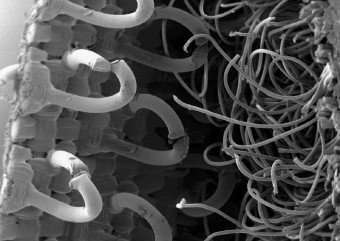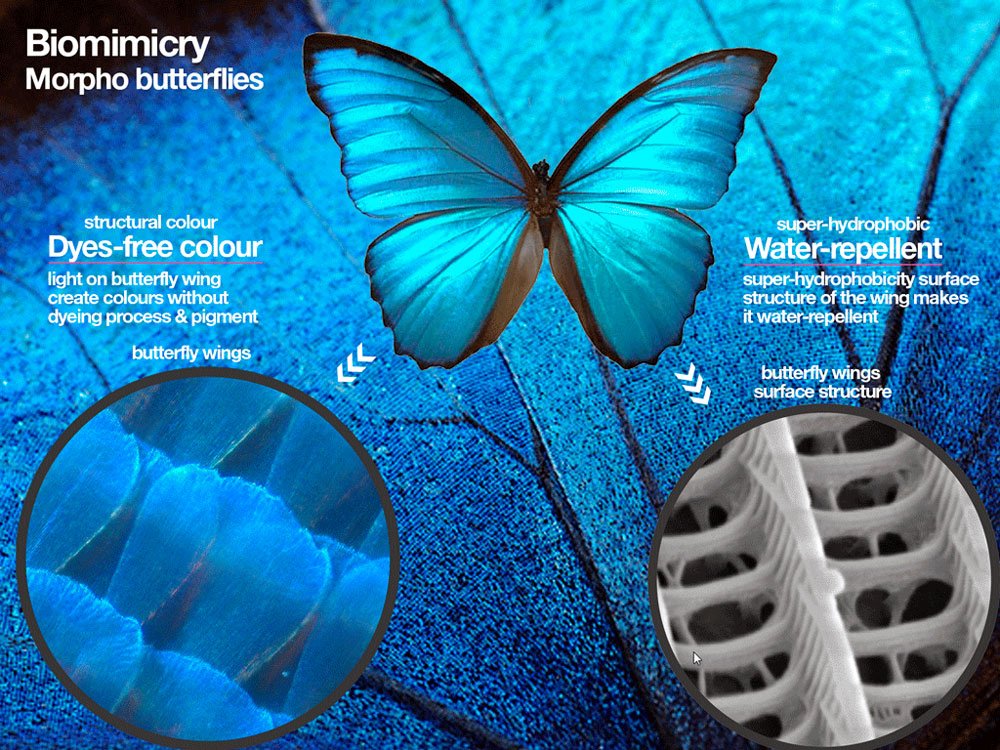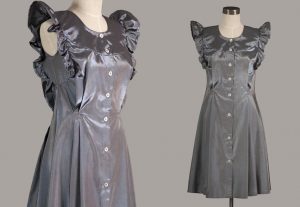Iridescent headpiece – https://youtu.be/-fviuL8D5vQ
Moving headpiece – https://youtu.be/kHIAPvJBf1w
Iridescent headpiece – https://youtu.be/-fviuL8D5vQ
Moving headpiece – https://youtu.be/kHIAPvJBf1w
Biomimicry derives from the Greek words, “bio” which means life and “mimesis” which means to imitate. Biomimicry encourages to look beyond the form or shape of an organism but to look into its “sustainable models constructed from complex natural systems”.
Janine Benyus describes biomimicry in three primary components:
“This human thing is about control, whereas the natural thing is about liberation.” – John Bradford
2.1 Velcro

During a walk in the woods, an electrical engineer Georde de Mestral was curious as to why the burdock seeds clung to his coat and his dog. With the burs of a burdock plant as a source of inspiration, he invented the velcro as a fastener in 1941.
2.2 Morpho Butterflies

The structural colouration of insects, such as the Morpho butterflies, is the centre of focus of Researchers in the Advanced Fiber-Based Materials (AFBM) Center of Economic Excellence at Clemson University. They are looking into creating materials that display colour by making use of the interference of white light reflected from several layers within each fibre. This results in an iridescent effect where it changes colour depending on the viewing angle, without the use of harmful dyes.

2.3 Snakeskin
3.1 Morphotex

“A fabric that imitates the microscopic structure of the wing using nanotechnology. This innovation also saves on water and energy used in conventional dyeing.”
3.2 Fastskin Line by Speedo

Inspired from the shark’s sandpaper-like skin that reduces drag, the Fastskin Line by Speedo is the “world’s fastest swimsuit”. Deemed as “technological doping”, it is banned from use in competitive swimming.
To end this off, from my research into biomimicry, I believe there are still so much of the natural environment that we can study from. The fashion industry is the second biggest polluters on the planet, and it is about time we look into sustainable fashion for the future.
“Design is not just about product. Design is about responsibility.”
https://animals.howstuffworks.com/insects/butterfly-colors.htm
http://www.osmosis-industries.com/digital/2015/4/21/nature-inspired-fashion-design-through-the-theory-of-biomimicry
Designed by: Intel and Becca McCharen
Reacts to “wearer’s stress levels and adrenal function, and change its shape accordingly.”
“The Curie Module sensors allow the dress to respond to both internal and external stressors by growing and shrinking based on the wearer’s biometric response. The dress itself is made of a memory alloy that can restore itself to its original shape after stretching or shrinking.”
Exploring the future of “sensitive” garments versus “intelligent”.
“It uses biometric sensing technology that senses your emotions on its inner layer and projects them onto the outer layer. The result is a beautiful dress that illuminates light patterns within its textiles and reacts differently to every individual.”
Creating a dress that “grows” as a children grow up as well.
https://www.fastcompany.com/40442036/these-expandable-kids-clothes-are-designed-to-grow-six-sizes